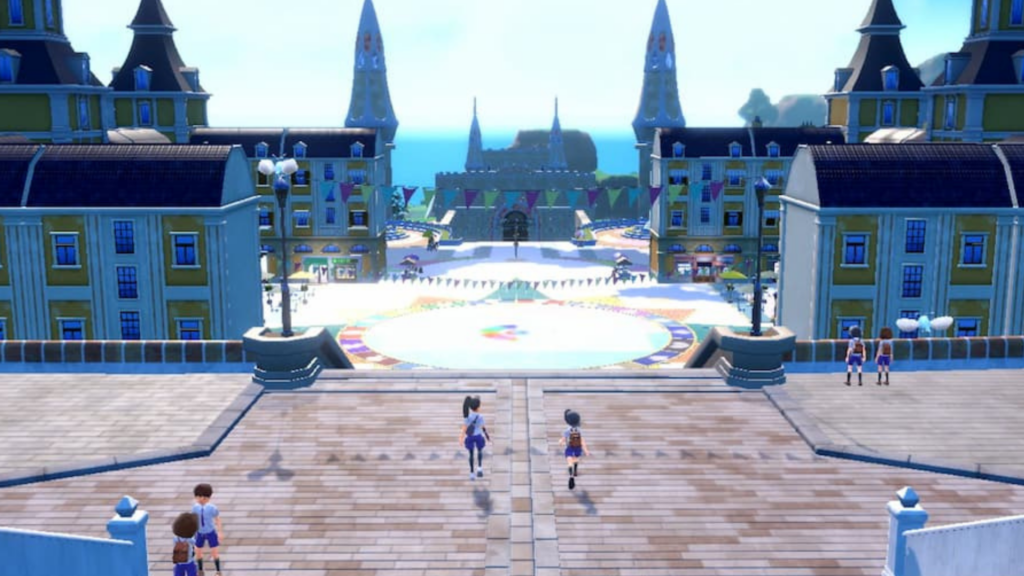What Region is Pokemon Scarlet and Violet Based on?

Pokemon is easily one of the biggest media franchises in history, and it should come as no surprise. Each game that comes out is accompanied by a wide array of interesting and fun Pokemon designs. And while there are certainly some designs that are worse than others, most Pokemon have their own fans. In addition to the differences in Pokemon added in a game, each game takes place in a new region, all of them being based on a real part of the world. But what region is Pokemon Scarlet and Violet based on?
These games represent the ninth pair of games in the mainline Pokemon series; Scarlet and Violet places the player in a region based on the Iberian Peninsula. This places players in a region that has inspirations from Spain, Portugal, and Andorra. However, it seems like Spain is the primary focus.
But what kinds of inspiration do Pokemon Scarlet and Violet take from the Iberian Peninsula?
What Region is Pokemon Scarlet and Violet Based on?
The region of Pokemon Scarlet and Violet – the Paldea region – is based on the Iberian Peninsula, which encompasses Spain, Portugal, and Andorra. While there is definitely inspiration from the latter two countries, a large number of the inspirations come from Spain. What is interesting, however, is the fact that a lot of people were convinced that the game was set in a Spain-like region before any hard confirmations were found. When the trailer was shown, it was pretty unambiguous that the region was based on at least Spain, since the live-action portion of the trailer had an actual map of Spain included.
The region is designed around a mountainous center, and players start in the southern portion of the map. The map is designed to allow you to explore more freely than any previous mainline Pokemon entry, with a variety of settings types represented. This includes snowy mountains, grasslands, a beach resort, and much more.
What inspirations are based on the Iberian Peninsula?

There are some overt examples of Spanish inspiration, which come in the form of the use of Spanish words. Two examples of this are the Spanish words Naranja and uva, which are translated into English as orange and grape respectively. There may be other words that translate into Spanish like this, but these instances should be enough to demonstrate the intent here.
Several landmarks appear in the region that seem to take inspiration from real-world landmarks. For instance, while the location is not in the right spot, the Real Madrid Towers appear to have inspired Paldea’s own set of four towers. In addition, the Naranja Academy and Uva Academy (the identity determined by which version you bought) exist in Paldea, and appear to have many similarities between it and the real-world Sagrada Familia, an unfinished church with a school built into it. This church/school is found in Barcelona, Catalonia, but geographically, liberties were taken with respect to the placement of the location.
Another thing that Scarlet and Violet takes from Barcelona in particular is a strongly similar aesthetic to Güell Park due to its ceramic and rock mosaics. Additionally, there’s a general aesthetic at play with respect to the number of buildings. Some houses, for instance, take a lot from Spanish architecture in particular.
This inspiration is not particular to any of the countries in the Iberian Peninsula, but at the same time, many cities in the Iberian Peninsula are noted for the popularity of motorcycles. For instance, Barcelona has the most motorcycles per resident of any European city. Europe tends to have a more normalized motorcycling culture, which definitely explains why Game Freak elected to add motorcycle-based Pokemon that you can ride around Paldea. Just like a lot of young people in Spain, Paldean trainers’ first vehicle, rather than on four wheels, is on two wheels instead.
To complement the motorcycle-themed Pokemon in these games, the Pokemon Centers – which tend to have a more hospital-themed design – instead appear to resemble gas stations. Once again, such locales are no strangers to many countries, but the mobile nature of your ridable Pokemon makes it feel tonally appropriate.
Another thing you may have noticed in Paldea is its windmills. Once again, Spain (and the rest of the Iberian Peninsula) does not have a monopoly on windmills, but it is fairly notable considering the fact that Spain’s biggest source of energy in 2021 there was wind energy. Another interesting tidbit about windmills could be from a Spanish literary character Don Quixote who, on his first chance to see a windmill, believes that they are giants and attacks them. He lost, by the way.
While Spain is definitely the bigger influence overall, it should not be said that it is the only influence. For example, Junichi Masuda – the former Managing Director of Game Freak – visited Portugal during the development of Scarlet and Violet. While he is not involved in the development of these games, it would definitely be an interesting coincidence if he went there during the development time of these games.
Potential mythological inspiration from the Iberian Peninsula
While this is not yet confirmed, it is possible that the three starting Pokemon may be taken from a specific piece of mythology from the Iberian Peninsula. This speculation came from Andrea Trama for Game Rant, based on leaks from a Pokemon Scarlet and Violet by the name of Riddler Khu. If this mythological link is accurate, it would make the starters based on an encounter between Saint George and a large beast named the Cucafera. This beast has crocodile-like features, such as scales, which lead to this speculation, since the Fire-starter Pokemon Fuecoco has these features as well.
Meanwhile, Quaxly, the Water starter, could very well be inspired by Saint George himself. The third starter, the Grass-type Sprigatito, is much more tenuous, with the connection merely being the claim by Riddler Khu that it will be both bipedal and feminine in nature. These connections could very well be pure speculation in the end, but it would be interesting to consider nonetheless.
Whether the starters turn out to be mythologically inspired or not, it is likely that we may see some Pokemon with mythological inspiration. Such inspiration has been frequent across the series. You can find them in each gen:
- Ninetales in Pokemon Red and Blue (based on a Kitsune from Japanese mythology)
- Dunsparce in Pokemon Gold and Silver (based on a Tsuchinoko from Japanese mythology)
- Relicanth in Pokemon Ruby and Sapphire (based on the mythology surrounding the real coelacanth fish)
- Infernape in Pokemon Diamond and Pearl (based on the mythology of Sun Wukong from Chinese mythology)
And many more beyond them.
Do Pokemon name puns in Scarlet and Violet take inspiration from this region?

Believe it or not, Paldea’s Spanish roots actually resulted in the Pokemon themselves having these inspirations as well. Who would have thought? Well, the first two confirmed instances of Spanish punnery include Sprigatito and Fuecoco. Sprigatito is a portmanteau of sprig and gatito, with the latter being the Spanish word for cat. Meanwhile, Fuecoco is a portmanteau of fuego (fire) and cocodrilo (crocodile). Quaxly, unlike the other two, is based on, well, the English word quack.
A lot of other Pokemon also have Spanish puns, such as Lechonk. This Pokemon appears to be a portmanteau of the neologism ‘chonk’ (typically referring to a fat and/or large animal) and lechón, the Spanish word for suckling piglet.
What is the Catalonia region?
Catalonia is considered to be a part of Spain, but it is also considered autonomous by some, including its Parliament. It consists of four provinces: Barcelona, Girona, Lleida, and Tarragona. Until very recently, this region was a part of Spain, and indisputably so. However, in recent years, an independence movement for this region of Spain has taken root, to the extent that the Parliament of Catalonia declared independence from Spain. However, whether it is separate from Spain, or if it is even possible for them to secede, is highly disputed by both Spain and much of the international community.
Regardless of the dispute over whether the Catalonia region is a part of Spain or not, there are certain things that seem to be taken from this region.
What are previous Pokemon regions based on?
Generally, the regions have focused on Japanese areas, at least until Pokemon Black and White came along. Kanto in Pokemon Red and Blue is based on the region of the same name (and pretty geographically accurate), while the next game – Pokemon Gold and Silver – is based on a mixture of the Kansai, Tokai, and eastern Shikoku regions. Hoenn from Pokemon Ruby and Sapphire is based on the Kyūshū region, and Sinnoh from Pokemon Diamond and Pearl is based primarily on Hokkaido island.
Since the first four games, the remaining games have all been based on non-Japanese regions. The first foray out of a Japanese inspiration was with Pokemon Black and White, which was based on both New York City and parts of New Jersey. Kalos in Pokemon X and Y is based on France and Alderney, Alola in Pokemon Sun and Moon is based on Hawaii, and Galar in Pokemon Sword and Shield is based primarily on England and Wales. However, the DLC areas are based on Scotland and the Isle of Man.
How similar is the regional layout of Paldea when compared to the Iberian Peninsula?
It is currently hard to say exactly how accurate Paldea is compared to this region of the world, though it cannot be denied that Pokemon games do make efforts to mimic real-world areas a lot. However, one Twitter user, @FavoriteMewArt, overlayed the maps of Paldea and Kalos over the real-world maps of Spain, Portugal, and France. In her observations, Kalos only seemed to represent northern France, which led her to speculate that Pokemon Scarlet and Violet could explore southern France, at least at some point in the future.
One interesting observation is that, while there are certain inspirations from the Catalonia region, the Paldea map does not overlay with Catalonia. Thus, it may be the case that Paldea is taking things from certain regions in the Iberian Peninsula, but not fretting too much about consistency.





